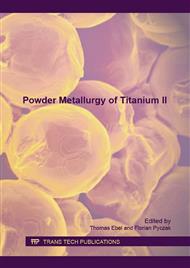p.343
p.351
p.360
p.369
p.378
p.388
p.400
p.406
p.413
Processing, Microstructure and High Strain Rate Behaviour of Ti-6Al-4V Alloy Produced from a Blended Mixture Using Powder Compact Extrusion
Abstract:
Powder compact extrusion (PCE) is an innovative way of processing titanium and titanium alloys to produce good-quality material with a wide range of compositions, microstructures and mechanical properties. This paper explores PCE processing of Ti-6Al-4V alloy prepared from a blended powder mixture, containing elemental hydride-dehydride (HDH) titanium powder and master alloy (60Al-40V) powder. The warm pressed compacts of blended powders were sintered using a vacuum sintering furnace prior to β extrusion. The resulting material was used to measure the performance under high strain rate and tri-axial stress state using Charpy v-notch testing. A comparison was made of the microstructure after vacuum sintering and hot extrusion in addition to oxygen measurements to determine the degree of oxygen pickup during each processing stage. A comprehensive study of fracture surfaces in selected samples was carried out using optical microscopy and scanning electron microscopy. Based on the results, it is clear that certain samples picked up varying amounts of interstitial impurities during processing and as a consequence a significant number of micro-cracks were observed in lamellar type microstructures. The oxygen content of all as-extruded samples was between 0.34-0.44 wt.% with resultant impact toughness in the range of 10-14 J. The best impact toughness attained for the lowest oxygen as-extruded rods was 20% lower than the literature values for wrought material. In terms of fracture behaviour, ductile dimples, cleavage facets and cracks passing through lamellar structures were observed in all samples. However, the quantity of these fracture features varied significantly in each sample.
Info:
Periodical:
Pages:
413-422
Citation:
Online since:
August 2016
Authors:
Price:
Сopyright:
© 2016 Trans Tech Publications Ltd. All Rights Reserved
Share:
Citation:


